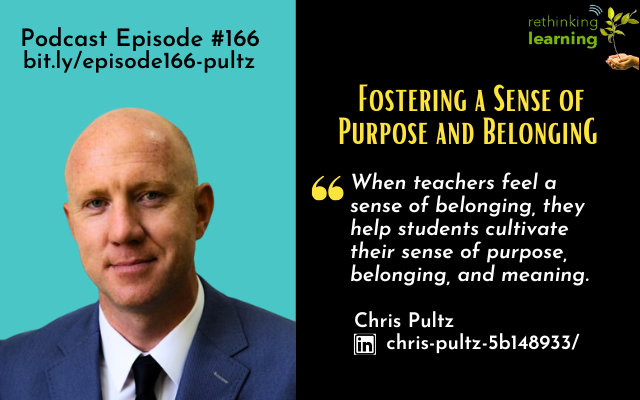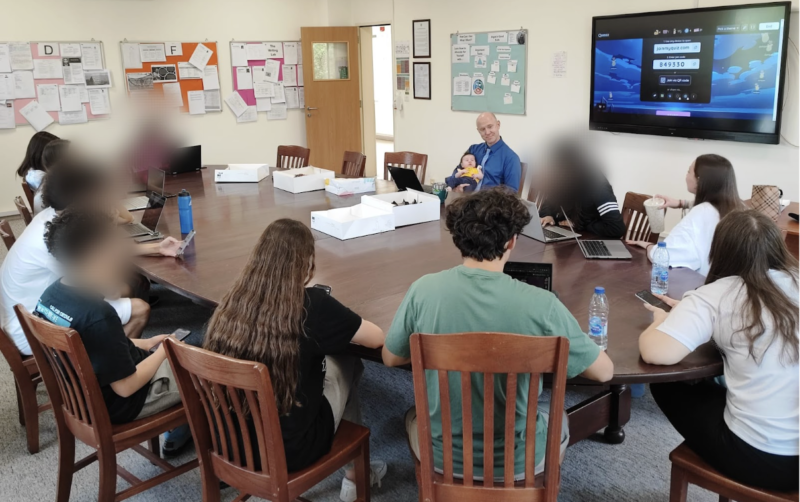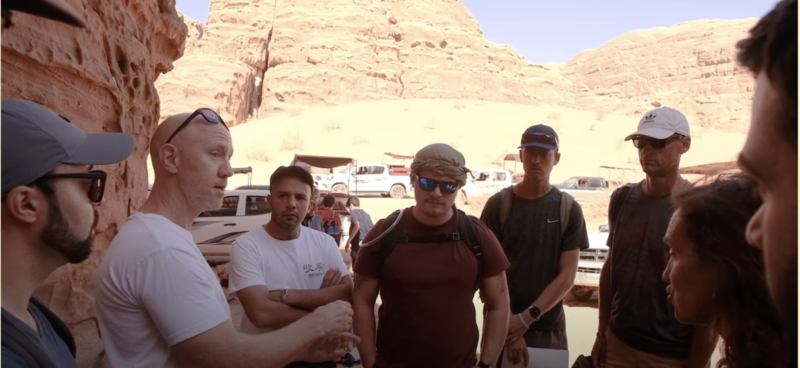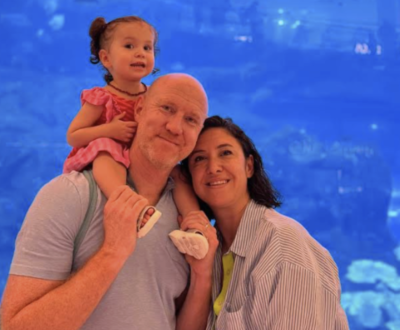
Podcast: Play in new window | Download
Subscribe: Spotify | TuneIn | RSS
Chris Pultz, an educator, was a Peace Corps volunteer in Madagascar and a Fulbright exchange teacher in Hungary. He has experience teaching in New York City public schools and international schools. He’s worked in Belarus, Turkiye, and Jordan. Chris lives in Istanbul, Turkiye with his wife, Gamze Keskin Pultz. His work with personalized and competency-based learning led him to focus on helping students foster a sense of purpose and belonging. Chris loves designing educational experiences that challenge students and allow them to thrive in a growingly complex world.
Your WHY
It’s evolved over the years, and it will likely continue to evolve, but for now, I would say it is “Helping Students find their why.” As best I can, I try to complement that WHY with my other WHY, which is “To be a loving and supportive husband and father.”
What was it like for you as a child in school?
I grew up in Long Island, New York where I attended public schools in large classes with tracking systems. It was a sports culture, which I enjoyed, but it left other sides of myself underdeveloped. I navigated that as best I could until I got to University.
When did you decide to become an educator?
At University, I volunteered for the Xerox Center for Multicultural Teacher Education. I sat in the back of a class during a vocabulary lesson. I didn’t know it by name then, but I experienced a flow state while identifying problems and imagining possible solutions. I got to work with some students who responded positively to simply seeing someone curious about them. I felt useful. I fed that and decided to do my student teaching in California, surfed every day, and developed competence in the classroom. I felt like one of the lucky ones who’d happily stumbled on what he wanted to do.

Who or what impacted you to change your path?
I returned to the university for my final semester and met with a professor I had for a freshman seminar on Ngugi Wa Thiong’o. My professor’s experiences in Kenya during his sabbatical impacted me. I said I wanted to do what he did, and he suggested I join the Peace Corps. So on graduation day, I told my parents, “Surprise. I’m moving to Madagascar.” I taught there and navigated the initial culture shock–learned a lot more than I taught–and felt the reverse culture shock even harder. My experiences there really turned my understanding of the world upside down.
It looked like you changed paths again. What happened?
I came back to New York and started my teaching career in New York City Public Schools. I enjoyed it, but I lost my father in my first year of teaching and that created another hole. I started a master’s degree in cultural anthropology, trying to keep busy, but also trying to make sense of a lot of what had been scrambled up. My naive thoughts about being a savior in New York started to show. I probably watched too many movies with sages on stage to understand the complexities of teaching, and then schools were pivoting to the trappings of No Child Left Behind.
I started feeling the burnout.
I took a Fulbright teaching exchange to Hungary, taught EAL, and lived an immersed life in a small city on the Romanian border. Loved it. Was offered a second year, but my boss wrote: “Get your ass back to Brooklyn.” I returned to Brooklyn for another two years and started to feel the burnout even more. This was about the time that teachers started getting publicly rated on their test scores. I knew I had to get out of there.
What encouraged you to move to Hungary?
I was involved with a small writing group where I took a shot at MFA programs. I was rejected by all. My backup plan was to try international teaching. I moved to Minsk thinking it would be just like my experience in Hungary. It was not, but I got to work with some great kids and colleagues and was introduced to mastery learning. I then moved on to Istanbul to explore the IB program and the personalized learning structures the school had put into place. I started adapting some of my own.
Video–Multidisciplinary Trip to Wadi Rum, Jordan

Can you tell me more about how you met your wife?
I was preparing to move on to the next spot, and then I was introduced to someone I didn’t want to be without. Gamze Keskin Pultz and I got married just after the coup attempt, so none of my family or friends could attend. Gamze gave up her corporate life on the road for a teaching assistant position at my school.
We decided to try international life together and took positions in Jordan. We thrived on the freedom we were given, taking what we’d learned with the IB and personalized learning and building it into competency-based learning systems. We had our daughter, Olivia Ada, there. My wife unfortunately lost her father three months into her pregnancy, and we decided we wanted to be a little closer to her family, so we moved back to Turkiye

Here we continue our work. Gamze is working freelance right now offering training on GenAI in schools and building resources for Turkish teachers to use. She was recently recognized by AI for Education as a “Pioneer in GenAI Literacy Awareness.”
I’ve taken my competency-based program and adapted it to a very grade-driven environment with quarterly common exams. It has proven challenging, but I push myself with the idea that if it can work here, it can work anywhere. And the kids need it. They are very bright, but they are amongst the most risk-averse students I’ve ever worked with, which points squarely to the system.
What message about purpose and belonging would you like to share with our audience?
Education is important and worth fighting for. One of the guiding principles I insist upon with my teams is that when we encounter frustrations, we pivot to curiosity. I have to remind myself of that one as well.
The symptoms are plain to see: mounting content, higher stakes, and fading meaning. Overloaded administrators slap motivational posters on the walls while teachers, already overwhelmed, are handed SEL lessons on top of their usual curriculum. And everyone is under a microscope. When that inevitably falters, we outsource the problem to business models, as if corporate logic can mend a fractured system.
We can do better.
There are great schools out there. Some are public, some private. The common thread is vision and purpose. These schools collaborate effectively to redesign learning with purpose at the core—not as an afterthought.
In these schools, SEL isn’t just a buzzword slapped on a bulletin board. It’s embedded in daily practice. Teachers are trusted as professionals, valued for their expertise, and given space to belong and thrive.
When teachers feel a sense of belonging, they help students cultivate their sense of purpose, belonging, and meaning.
One idea that I’ve found effective in my practice is to focus explicitly on purpose. I have my students create a statement of purpose—a long-term goal tied to personal interests that positively impact others. They put this on top of their CV, which is how I design my student portfolios. Some students struggle to create a statement of purpose, so we compromise on an intermediate statement of “I am actively pursuing my interests, considering long-term goals I might set and how this work might benefit others.”
We follow up this work by creating a student-directed learning contract where they write SMART goals connected to our core competencies. I dedicate one class period per week to student-directed learning time, allowing students to design their own learning experiences aligned with the goals they’ve set. The curriculum supports this process by providing content and skill development that allows for personalized pathways towards meeting learning outcomes while each student keeps sight of how this work relates to their purpose.
Student performance is still assessed by rubrics, but it is collected in their CVs. Here is an AI-generated sample. Students argue for their level of mastery with oral reflections and a formal interview. While I would prefer not to have to use grades and just stick with levels of mastery, which programs such as Mastery Transcript Consortium support, I’ve done this work in grade-based systems, and we’ve been able to make it work.
This isn’t an SEL “add-on.” It’s a redesign of how we teach. When students have agency over their learning, content, and skills take on new significance. And when you have a classroom full of students pursuing their purpose, the culture becomes one of belonging and collaboration. It’s not without its bumps and snags, but I’ve found this approach to be incredibly effective and rewarding.
If your school doesn’t yet have a clear vision in place, then maybe the work to change it starts with you. And no, that doesn’t mean hopping on a soapbox. Grandstanding only adds to the noise; I’ve learned that the hard way. Instead, work within your parameters. Build connections. Make bridges. Start small but dream big.
Our kids deserve it.
What’s next?
Gamze and I accepted positions at the American International School of Dhaka for next year. This will be an exciting new adventure. We were lucky to be able to choose a place that offers a strong community and will give our daughter access to a great education while keeping us all in one place and continuing to collaborate on the work we love.
We have floated some ideas about consultancy, and we’ve also explored the idea of offering a summer camp on the Turkish coast, offering some of the educational projects we’ve created to an expanded audience.
In the meanwhile, I still feel like I’m that university student sitting in the back of the classroom, identifying problems, asking questions, and attacking them with what-ifs.
****

Chris Pultz’s Contact Information
Website: MrPultz.com
LinkedIn: linkedin.com/in/chris-pultz-5b148933
****
I hope you enjoyed my conversation with Chris Pultz who I met at the Human Intelligence Movement Symposium. After learning about his work with personalized learning and purpose, I realized we had so much in common. I am grateful that Chris shared his story and his WHY on my virtual porch. I know you will find his journey interesting and inspiring Please share this post and podcast with your friends and make sure you connect with Chris.
*****
| Make sure you check out more of the Rethinking Learning podcasts and each post that the guests created. Click on this link or the logo below to list by episode, alphabetical, or reflections. | I am a co-host of a new podcast “Real Talk with Barbara and Nicole.” Check out the episodes about Authenticity in a Polarized Society around different topics. Click on RealTalkBN or the logo below. |
I’m getting wonderful feedback on how much the information and stories in “Define Your Why” has helped them. For more information about this book, go to this page or click on the book for resources, questions, and links. |
My new book, “Grow Your Why…One Story at a Time” includes 23 stories from inspirational educators, innovators, and entrepreneurs. Go to this page or click on the book to go to Why Press Publishing for launching, details, and resources. |





